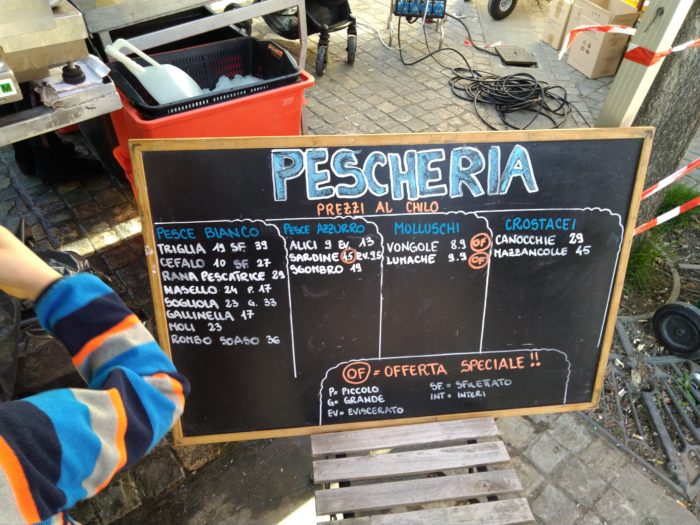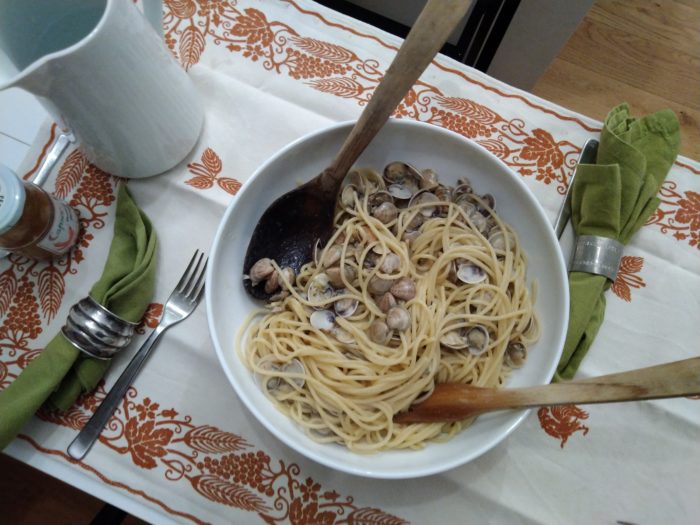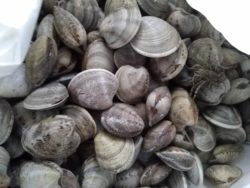Travel Alert: Shopping Italian Food Markets 101
January 23, 2019Italian Food Misadventures 101
 I’ve lived in Italy for almost twenty years and I have had many culinary adventures and mishaps along the way. One of the most memorable was trying my hand at spaghetti alle vongole, a.k.a. spaghetti with clams. I love seafood. My husband loves seafood. What better way to enjoy one of our shared passions than a padellata of pasta drenched in the tasty riches of the Adriatic Sea? So I asked my husband what his recipe for spaghetti alle vongole was and he burst out laughing. Thus was born a question that has since colored all our cooking conversations.
I’ve lived in Italy for almost twenty years and I have had many culinary adventures and mishaps along the way. One of the most memorable was trying my hand at spaghetti alle vongole, a.k.a. spaghetti with clams. I love seafood. My husband loves seafood. What better way to enjoy one of our shared passions than a padellata of pasta drenched in the tasty riches of the Adriatic Sea? So I asked my husband what his recipe for spaghetti alle vongole was and he burst out laughing. Thus was born a question that has since colored all our cooking conversations.
Ricetta O Preparazione?
My husband looked at me with an incredulous expression, “What do you mean recipe? You get some clams and cook them. Then you cook some spaghetti and finish them in a pan with the clams and their juice. That’s it. There is no recipe.” He expounded further saying that it was just a preparazione and not a ricetta, meaning that the dish required nothing more than a procedure of cooking ingredients together with no specific measurements involved or complicated techniques. My recipe-coddling self begged to differ, so I looked it up online. Ha! 800,000 results. How could I go wrong with “Our Step by Step Recipe for Spaghetti alle Vongole”?
I read through a couple and got the gist of the preparazione. I had to admit that at times the need for a recipe is to fill in for experience you haven’t had. Growing up near the Mediterranean and hanging out in kitchens while friends prepared ragù or other Italian specialties just wasn’t my background. Having that piece of paper or webpage with clear instructions fills in for the lack of knowledge and confidence when exploring unknown culinary terrain. We all want what we serve our families, our friends and ourselves to be delicious, and to be guiltless if it isn’t. So, if following the recipe for the carbonara doesn’t work out, you’ve got something you can blame.
“How To Cook [Fill In The Blank] Without A Recipe”
So, springing from the confidence of more experience, here it is, spaghetti  alle vongole without a recipe. For about four people I normally use 2 lbs. of clams, preferably smaller ones. In Italy my favorite clams are lupini, which I get in Bologna from Pescevia at Mercato Ritrovato. Vongole veraci are frequently sold here as the clam for this dish, but the original wild species has been mostly replaced with a cultivated specimen FYI. More on that later. Stateside opt for littlenecks or Manila clams.
alle vongole without a recipe. For about four people I normally use 2 lbs. of clams, preferably smaller ones. In Italy my favorite clams are lupini, which I get in Bologna from Pescevia at Mercato Ritrovato. Vongole veraci are frequently sold here as the clam for this dish, but the original wild species has been mostly replaced with a cultivated specimen FYI. More on that later. Stateside opt for littlenecks or Manila clams.
Put the clams in a colander and set it in a bowl with cold water for a couple of hours. Change the water a few times. The idea is to clean the sand off of them. Remove any clams with broken shells. Once you’re ready to cook, put a generous amount of olive oil in a pan and a clove or two of garlic. Once the garlic starts sizzling, add the drained claims and cover with a lid. Shake the pan as they cook so they all open. Turn off the heat once the clams have opened. You should have a nice sughetto at the bottom of the pan. Remove the clams from the pan, and start cooking about 1/2 to 1 lb. of spaghetti in boiling water. When the pasta is still very al dente, fire up the clams’ cooking liquid, remove the pasta  from the boiling water and drop it into the clam sughetto, adding some of the pasta’s starch-rich cooking liquid as needed for a denser, creamier finish. Give it one last whirl with the clams, turn off the burner and serve. Add chopped parsley, black pepper or hot pepper to your liking. Just in case you’re like me, here is a video you can use for your preparazione from Giallo Zafferano.
from the boiling water and drop it into the clam sughetto, adding some of the pasta’s starch-rich cooking liquid as needed for a denser, creamier finish. Give it one last whirl with the clams, turn off the burner and serve. Add chopped parsley, black pepper or hot pepper to your liking. Just in case you’re like me, here is a video you can use for your preparazione from Giallo Zafferano.
What Kind Of Clam Are You?
Here’s the scoop on what you might be eating when you order a spaghetti alle vongole during your next Italian vacay. Once upon a time, there was a little clam called Venerupis decussata, known commonly in Italy as vongola verace (translates literally to “genuine clam”) and apparently the one for this dish. For commercial reasons,  another little clam named Ruditapes philippinarum, native to Asian waters, was planted in the Adriatic for cultivation. Under Italian law, this clam too may be called vongola verace. Fishmongers and restauranters play off this misleading nomenclature to convince you you’re getting the “real clam”. Feel free to inquire about their heritage.
another little clam named Ruditapes philippinarum, native to Asian waters, was planted in the Adriatic for cultivation. Under Italian law, this clam too may be called vongola verace. Fishmongers and restauranters play off this misleading nomenclature to convince you you’re getting the “real clam”. Feel free to inquire about their heritage.
